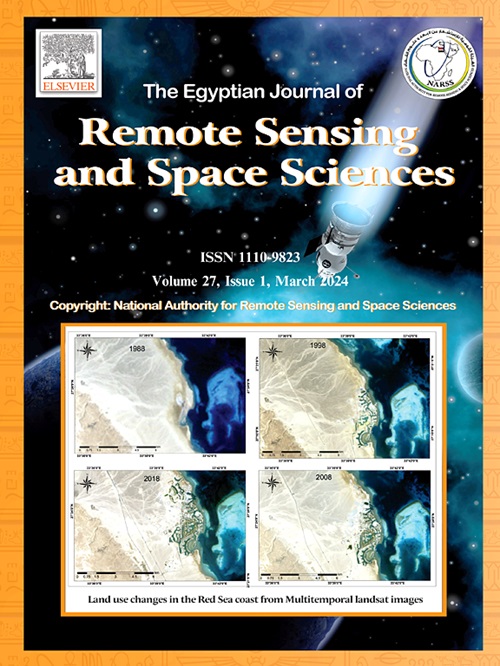Fusing satellite imagery and ground geochemical data to map alteration zones for gold exploration in western Nigeria
IF 3.7
3区 地球科学
Q2 ENVIRONMENTAL SCIENCES
Egyptian Journal of Remote Sensing and Space Sciences
Pub Date : 2025-01-16
DOI:10.1016/j.ejrs.2025.01.001
引用次数: 0
Abstract
As alteration mapping is vital in identifying signatures of specific mineral deposits, this study aimed to map alteration zones associated with orogenic gold mineralization in the Wawa area using remote sensing and geochemical data. Sentinel-2 satellite images were fused with an ALOS PRISM panchromatic image for spatial resolution enhancement. Image processing methods such as color compositing, band rationing, thresholding, and principal component analysis were used for hydrothermal alteration mapping. Field investigations, major, and trace element geochemical analysis of samples were applied for results validation. The findings showed that the significant lithologies in the Wawa area are migmatite, granite gneiss, quartzite, amphibolite/amphibole schist, phyllite, and granites. Gold occurs as micro-veins within amphibolite/amphibole schist and granite gneisses in close association with pyrite. Significant alterations observed at/around the gold mining sites are clay and iron oxide. There is increased alteration intensity at apparent contact zones between granite gneisses and schists. Geochemical data support the findings that most existing gold mining sites are within intense iron oxide and clay alteration zones, and that gold pathfinder elements such as Cu, As, Pb, and Ni occur anomalously within vein quartz and amphibolitic rock samples from the alteration zones in the Wawa area. Future exploration targets for orogenic gold in the Wawa area should be concentrated within similar alteration zones with no gold mining sites.
融合卫星图像和地面地球化学数据绘制尼日利亚西部金矿蚀变带图
由于蚀变填图对于识别特定矿床特征至关重要,本研究旨在利用遥感和地球化学数据对Wawa地区造山带金矿化相关的蚀变带进行填图。将Sentinel-2卫星图像与ALOS PRISM全色图像融合以增强空间分辨率。采用颜色合成、波段定量、阈值分割、主成分分析等图像处理方法进行热液蚀变制图。采用野外调查、主要元素和微量元素地球化学分析对样品进行验证。结果表明,瓦洼地区主要岩性为混辉岩、花岗片麻岩、石英岩、角闪岩/角闪岩、千层岩和花岗岩。金以微脉状赋存于角闪岩/角闪岩片岩和花岗片麻岩中,与黄铁矿密切相关。在金矿附近观察到的显著变化是粘土和氧化铁。花岗岩片麻岩与片岩的明显接触带蚀变强度增大。地球化学数据支持了现有金矿点大多位于强氧化铁蚀变带和粘土蚀变带内的发现,并且在Wawa地区蚀变带的脉状石英和角闪岩样品中异常出现了Cu、as、Pb和Ni等寻金元素。今后瓦洼地区造山带金矿的找矿目标应集中在无金矿点的蚀变带内。
本文章由计算机程序翻译,如有差异,请以英文原文为准。
求助全文
约1分钟内获得全文
求助全文
来源期刊
CiteScore
8.10
自引率
0.00%
发文量
85
审稿时长
48 weeks
期刊介绍:
The Egyptian Journal of Remote Sensing and Space Sciences (EJRS) encompasses a comprehensive range of topics within Remote Sensing, Geographic Information Systems (GIS), planetary geology, and space technology development, including theories, applications, and modeling. EJRS aims to disseminate high-quality, peer-reviewed research focusing on the advancement of remote sensing and GIS technologies and their practical applications for effective planning, sustainable development, and environmental resource conservation. The journal particularly welcomes innovative papers with broad scientific appeal.

 求助内容:
求助内容: 应助结果提醒方式:
应助结果提醒方式:


